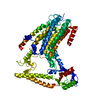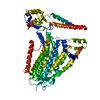+ Open data
Open data
- Basic information
Basic information
| Entry | Database: PDB / ID: 8ehx | ||||||
|---|---|---|---|---|---|---|---|
| Title | cryo-EM structure of TMEM63B in LMNG | ||||||
 Components Components | CSC1-like protein 2 | ||||||
 Keywords Keywords | MEMBRANE PROTEIN / ion channel / mechanosensitive / monomeric | ||||||
| Function / homology |  Function and homology information Function and homology informationalveolar lamellar body membrane / sphingomyelin transfer activity / surfactant secretion / phosphatidylcholine transfer activity / mechanosensitive monoatomic cation channel activity / osmolarity-sensing monoatomic cation channel activity / phospholipid scramblase activity / intestinal stem cell homeostasis / drinking behavior / mechanosensitive monoatomic ion channel activity ...alveolar lamellar body membrane / sphingomyelin transfer activity / surfactant secretion / phosphatidylcholine transfer activity / mechanosensitive monoatomic cation channel activity / osmolarity-sensing monoatomic cation channel activity / phospholipid scramblase activity / intestinal stem cell homeostasis / drinking behavior / mechanosensitive monoatomic ion channel activity / calcium-activated cation channel activity / exocytosis / sensory perception of sound / actin cytoskeleton / early endosome membrane / lysosomal membrane / plasma membrane Similarity search - Function | ||||||
| Biological species |  Homo sapiens (human) Homo sapiens (human) | ||||||
| Method | ELECTRON MICROSCOPY / single particle reconstruction / cryo EM / Resolution: 3.6 Å | ||||||
 Authors Authors | Zheng, W. / Fu, T.M. / Holt, J.R. | ||||||
| Funding support |  United States, 1items United States, 1items
| ||||||
 Citation Citation |  Journal: Neuron / Year: 2023 Journal: Neuron / Year: 2023Title: TMEM63 proteins function as monomeric high-threshold mechanosensitive ion channels. Authors: Wang Zheng / Shaun Rawson / Zhangfei Shen / Elakkiya Tamilselvan / Harper E Smith / Julia Halford / Chen Shen / Swetha E Murthy / Maximilian H Ulbrich / Marcos Sotomayor / Tian-Min Fu / Jeffrey R Holt /   Abstract: OSCA/TMEM63s form mechanically activated (MA) ion channels in plants and animals, respectively. OSCAs and related TMEM16s and transmembrane channel-like (TMC) proteins form homodimers with two pores. ...OSCA/TMEM63s form mechanically activated (MA) ion channels in plants and animals, respectively. OSCAs and related TMEM16s and transmembrane channel-like (TMC) proteins form homodimers with two pores. Here, we uncover an unanticipated monomeric configuration of TMEM63 proteins. Structures of TMEM63A and TMEM63B (referred to as TMEM63s) revealed a single highly restricted pore. Functional analyses demonstrated that TMEM63s are bona fide mechanosensitive ion channels, characterized by small conductance and high thresholds. TMEM63s possess evolutionary variations in the intracellular linker IL2, which mediates dimerization in OSCAs. Replacement of OSCA1.2 IL2 with TMEM63A IL2 or mutations to key variable residues resulted in monomeric OSCA1.2 and MA currents with significantly higher thresholds. Structural analyses revealed substantial conformational differences in the mechano-sensing domain IL2 and gating helix TM6 between TMEM63s and OSCA1.2. Our studies reveal that mechanosensitivity in OSCA/TMEM63 channels is affected by oligomerization and suggest gating mechanisms that may be shared by OSCA/TMEM63, TMEM16, and TMC channels. | ||||||
| History |
|
- Structure visualization
Structure visualization
| Structure viewer | Molecule:  Molmil Molmil Jmol/JSmol Jmol/JSmol |
|---|
- Downloads & links
Downloads & links
- Download
Download
| PDBx/mmCIF format |  8ehx.cif.gz 8ehx.cif.gz | 127.1 KB | Display |  PDBx/mmCIF format PDBx/mmCIF format |
|---|---|---|---|---|
| PDB format |  pdb8ehx.ent.gz pdb8ehx.ent.gz | 96.1 KB | Display |  PDB format PDB format |
| PDBx/mmJSON format |  8ehx.json.gz 8ehx.json.gz | Tree view |  PDBx/mmJSON format PDBx/mmJSON format | |
| Others |  Other downloads Other downloads |
-Validation report
| Summary document |  8ehx_validation.pdf.gz 8ehx_validation.pdf.gz | 1.4 MB | Display |  wwPDB validaton report wwPDB validaton report |
|---|---|---|---|---|
| Full document |  8ehx_full_validation.pdf.gz 8ehx_full_validation.pdf.gz | 1.4 MB | Display | |
| Data in XML |  8ehx_validation.xml.gz 8ehx_validation.xml.gz | 31.3 KB | Display | |
| Data in CIF |  8ehx_validation.cif.gz 8ehx_validation.cif.gz | 43.7 KB | Display | |
| Arichive directory |  https://data.pdbj.org/pub/pdb/validation_reports/eh/8ehx https://data.pdbj.org/pub/pdb/validation_reports/eh/8ehx ftp://data.pdbj.org/pub/pdb/validation_reports/eh/8ehx ftp://data.pdbj.org/pub/pdb/validation_reports/eh/8ehx | HTTPS FTP |
-Related structure data
| Related structure data |  28154MC  8ehwC M: map data used to model this data C: citing same article ( |
|---|---|
| Similar structure data | Similarity search - Function & homology  F&H Search F&H Search |
- Links
Links
- Assembly
Assembly
| Deposited unit | 
|
|---|---|
| 1 |
|
- Components
Components
| #1: Protein | Mass: 96051.203 Da / Num. of mol.: 1 Source method: isolated from a genetically manipulated source Source: (gene. exp.)  Homo sapiens (human) / Gene: TMEM63B, C6orf110 / Cell line (production host): Expi293 / Production host: Homo sapiens (human) / Gene: TMEM63B, C6orf110 / Cell line (production host): Expi293 / Production host:  Homo sapiens (human) / References: UniProt: Q5T3F8 Homo sapiens (human) / References: UniProt: Q5T3F8 |
|---|---|
| Has protein modification | Y |
-Experimental details
-Experiment
| Experiment | Method: ELECTRON MICROSCOPY |
|---|---|
| EM experiment | Aggregation state: PARTICLE / 3D reconstruction method: single particle reconstruction |
- Sample preparation
Sample preparation
| Component | Name: TMEM63B purified protein in LMNG / Type: COMPLEX / Entity ID: all / Source: RECOMBINANT | |||||||||||||||
|---|---|---|---|---|---|---|---|---|---|---|---|---|---|---|---|---|
| Molecular weight | Value: 0.11 MDa / Experimental value: YES | |||||||||||||||
| Source (natural) | Organism:  Homo sapiens (human) Homo sapiens (human) | |||||||||||||||
| Source (recombinant) | Organism:  Homo sapiens (human) Homo sapiens (human) | |||||||||||||||
| Buffer solution | pH: 7.4 | |||||||||||||||
| Buffer component |
| |||||||||||||||
| Specimen | Conc.: 2.5 mg/ml / Embedding applied: NO / Shadowing applied: NO / Staining applied: NO / Vitrification applied: YES | |||||||||||||||
| Specimen support | Grid material: GOLD / Grid mesh size: 400 divisions/in. / Grid type: Quantifoil R1.2/1.3 | |||||||||||||||
| Vitrification | Instrument: FEI VITROBOT MARK IV / Cryogen name: ETHANE / Humidity: 100 % / Chamber temperature: 279 K |
- Electron microscopy imaging
Electron microscopy imaging
| Experimental equipment |  Model: Titan Krios / Image courtesy: FEI Company |
|---|---|
| Microscopy | Model: FEI TITAN KRIOS |
| Electron gun | Electron source:  FIELD EMISSION GUN / Accelerating voltage: 300 kV / Illumination mode: FLOOD BEAM FIELD EMISSION GUN / Accelerating voltage: 300 kV / Illumination mode: FLOOD BEAM |
| Electron lens | Mode: BRIGHT FIELD / Nominal magnification: 105000 X / Nominal defocus max: 2100 nm / Nominal defocus min: 800 nm / Cs: 2.7 mm / C2 aperture diameter: 50 µm / Alignment procedure: COMA FREE |
| Specimen holder | Cryogen: NITROGEN / Specimen holder model: FEI TITAN KRIOS AUTOGRID HOLDER |
| Image recording | Average exposure time: 2.8 sec. / Electron dose: 53 e/Å2 / Film or detector model: GATAN K3 (6k x 4k) |
| EM imaging optics | Energyfilter slit width: 20 eV |
- Processing
Processing
| EM software |
| ||||||||||||||||||||||||||||
|---|---|---|---|---|---|---|---|---|---|---|---|---|---|---|---|---|---|---|---|---|---|---|---|---|---|---|---|---|---|
| CTF correction | Type: PHASE FLIPPING AND AMPLITUDE CORRECTION | ||||||||||||||||||||||||||||
| Symmetry | Point symmetry: C1 (asymmetric) | ||||||||||||||||||||||||||||
| 3D reconstruction | Resolution: 3.6 Å / Resolution method: FSC 0.143 CUT-OFF / Num. of particles: 198144 / Algorithm: BACK PROJECTION / Symmetry type: POINT | ||||||||||||||||||||||||||||
| Atomic model building | Protocol: AB INITIO MODEL / Space: REAL |
 Movie
Movie Controller
Controller




 PDBj
PDBj